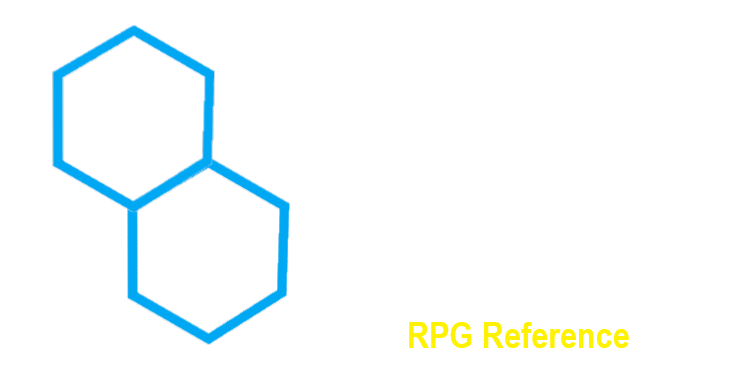 RPG Reference
Home . What's New
|
|
|
 |
 |
|
|
2300AD Classic Reference Page 2300AD Downloads | Similar Backgrounds: Alien / Aliens Series | Universe Fiction: Fifth Foreign Legion Challenge Magazine | Travellers' Digest BROWSE MY 2300AD ITEMS CURRENTLY IN STOCK  Photos and quotes by David Nilsen.  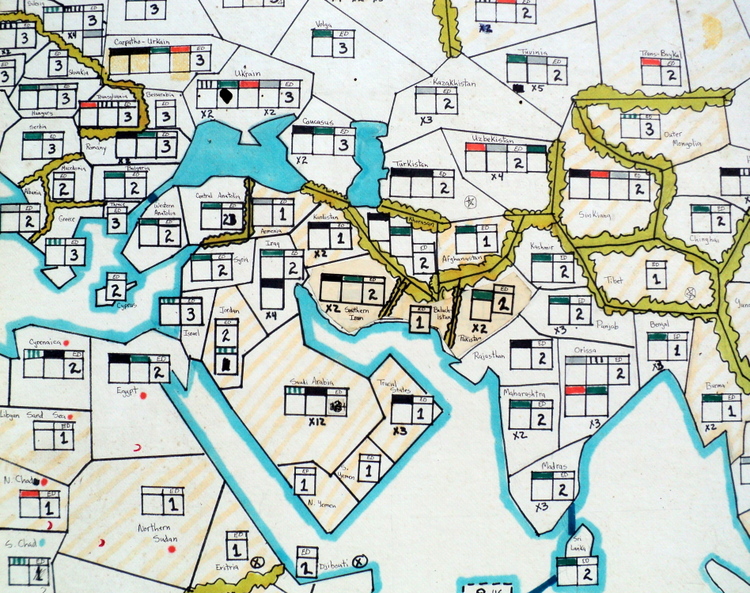
 As players of 2300AD know, the game universe is the same as that of Twilight: 2000, only 300 years in the future. But how was that intervening 300 years developed by the staff of GDW? The following is from the Traveller: 2300 Referee's Manual. "The background history for Traveller: 2300 was developed over the course of 1985-86 using a grand social-political-economic-military-diplomatic simulation known fondly here as The Game. The future course of history depended not on just one person's ideas as of what the future would be like, but on the interaction of many people's ideas — the ones that survived were the ones that withstood the conflict and diplomacy of The Game. Beginning with the conduct of World War III, players manipulated their nations on five or ten year turns to bring them into the future of 2300. Players in The Game were— John Astell (Mexico, Romania, and India). Rich Banner (Russia, Zimbabwe, and Canada). Kevin Brown (Cuba, the Ukraine, and Australia). Timothy B. Brown (United Kingdom, Algeria, and Manchuria). Larry Butz (Venezuela, Italy, Iran, and Angola). John Harshman (France, Argentina, and Israel). Dr. David MacDonald (Military Government of the United States, Poland, and Canton). Marc W. Miller (Azania, Japan, Bolivia, and Egypt). Matt Renner (Civilian Government of the United States, Sweden, and Nigeria). Wayne Roth (Brazil, Spain, and Turkey). Loren Wiseman (New America, Germany, and Indonesia). Frank Chadwick (Referee and kibbitzing player)."  The rules for The Game can be found online But missing are the charts -- and most notably -- The Map.  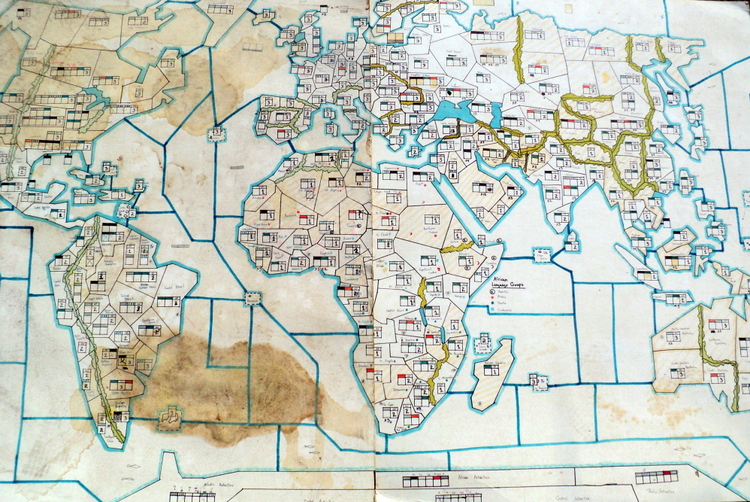 Both halves of the world map. Western Hemisphere shows damage from cats that lived in the GDW warehouse.  Here's where GDW alumnus (1991-5) David Nilsen (Traveller Line Manager, and later GDW Chief of Design) enters the story. For simplicity's sake, all further quotes are from Mr. Nilsen. These are from emails, late June/early July 2012. "I have The Game board. You probably know that they gave out copies of "The Game" rules at the summer cons back around 1988. But the rules did not include the map. The map is two pieces of artists board, with the world hand-drawn on it in colored markers. It was sitting in the GDW warehouse when I visited GDW back then, covered in dried, stinky cat pee (the warehouse had one or more resident cats), gluing the counters to it. It was still there when I worked at GDW starting in 1991. It had yellow pee stains on it, but didn't really smell anymore, but it had been walked on, and time was clearly not being kind to it. And since warehouse clean-ups would periodically throw away stuff, I eventually decided to rescue it."  The Design: "This is the map of "The Game" that formed the basis for the Traveller:2300/2300 AD game background. It is two sheets of artists board, each 39 1/2 by 32 inches. It was drawn by Frank [Chadwick], and is pretty typical of a designer's hand-drawn wargame map, the sort of thing that playtesters would play on. It shows a couple of things about Frank's design skills. One is his graphic sense. I think the map is very attractively done, clean, and functional. The other is something that most people don't think of, which is Frank's great skill in creating maps. In making a wargame map you don't just take an existing map and throw a hex grid over it, you actually have to make a new map that gets at the spatial and causal relationships the game has to present. All maps are imperfect, flat representations of a "spherical" surface, and come in many varieties (Mercator, equidistant, equal-area, etc.), and the map you're trying to make never falls in the middle of an existing map, and the four maps you're trying to use always come together with a lot of distortion. So you have to rationalize them onto your game map without distorting actual distances and relationships. While this map is not a hex-grid, you can see some of the same principles by the way Frank has played with sizes, shapes, and locations to keep land masses and water bodies in their essential relationships while making useful play areas, areas to display information, etc. Another aspect of this is how to handle terrain features, i.e., do you have mountain hexes, or hexsides? On this map Frank has set up his regions to be bounded by terrain obstacles, limiting movement. A well-made map simplifies the rules by embedding the game logic into the map and resolving land and water areas so that they are separate rather than mixed. I think this is a really nice map." The Wax: "Here's the thing about the map, though. It had been heavily modified over the course of the game, with the addition of waxed-on holding boxes and resource markings and stuff. Back in the days of pre-computer publishing, we "pasted up" camera ready pages to send to the printers, but nothing was actually pasted. The orange mylar "screens" that created the grey rows on tables or over sidebars were taped down, but things like artwork were waxed down. Every table in the art department had a wax heater on it, a little orange gadget about the size of a cigar box which plugged into the wall and heated up blocks of wax so it was liquid. It had a little tractor-feed, grooved roller on top, and you'd run your artwork or whatever you wanted to stick onto something else through it, and it would put beads of hot, sticky wax on the back, and you'd roll it down to stick it onto the paste-up pages. So, no one at GDW ever used elmer's glue or rubber cement, everything was always just waxed to other things. So, as The Game progressed and they decided, "new resources discovered here," or whatever, they would cut out new markers or holding boxes and wax them down onto the map. Wax was good because it was flexible and didn't pucker the paper, but after a few years it would lose adhesion and whatever was waxed down would fall off. Or in some cases as you can see, stuff was just hand-drawn directly onto the map."  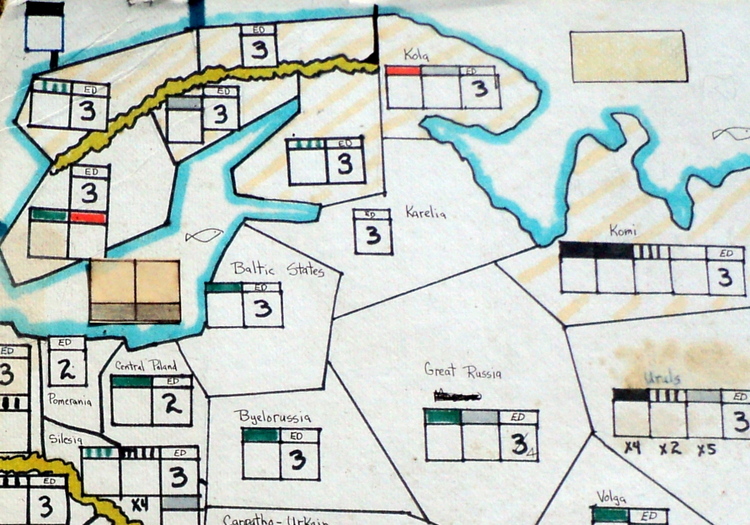 "I believe that the yellow diagonals are rough terrain regions. Note original waxed-down holding boxes in Baltic Sea, yellowish from the wax beneath. Compare this to the rectangle to the right of Scandinavian Peninsula where the waxed-down boxes have flaked off. Also note the fishies drawn in in these and other water areas, which I find charming. Me, personally, I always draw in dragons and sea serpents, but fishies are nice. I have wondered if the fishies are intended to show game-related effects, such as the size of fisheries in that area, but since there are no holding boxes there, assume that they are simply decorative."  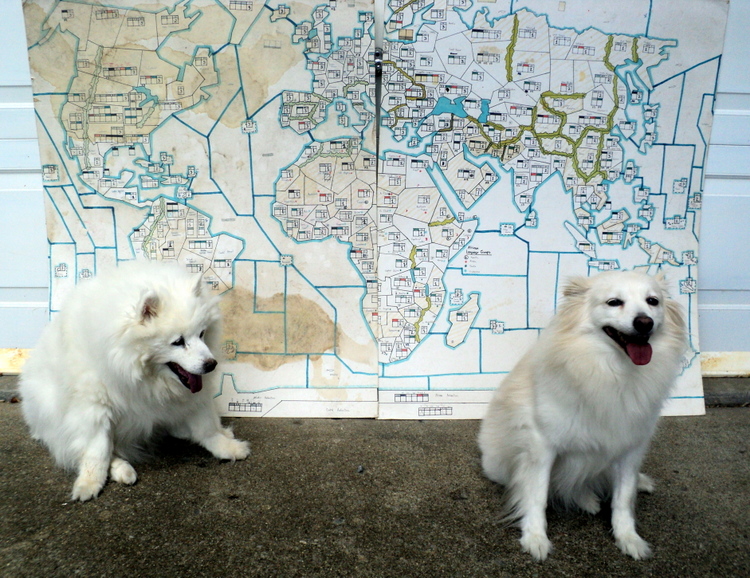 How big is the map? BIG. Here is a photo of the map propped up against Dave Nilsen's garage. His dogs -- USS Constellation (CV 64) left, and USS Coral Sea (CV 43) right -- give reference to the map's size.  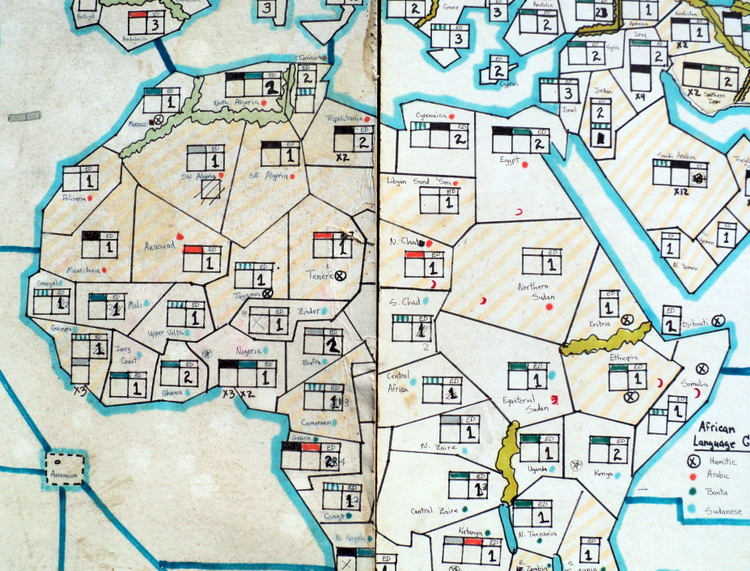 "Note from evidence on the map that the black holding boxes are oil, due to x12 in Saudi, x4 in Iraq. Also note little red crescents in Africa, clearly added later in game development. Presumably these indicate Islamic cultural influence. Also note African language groups key. Language was a significant portion of the game. I have heard Frank [Chadwick] say many times that Brazil would/will not be as successful as might otherwise be the case as it speaks Portuguese instead of Spanish. And The Game was Frank’s game, so his underlying intents and assumptions, although they would be influenced and changed as the game progressed, would still influence its results."  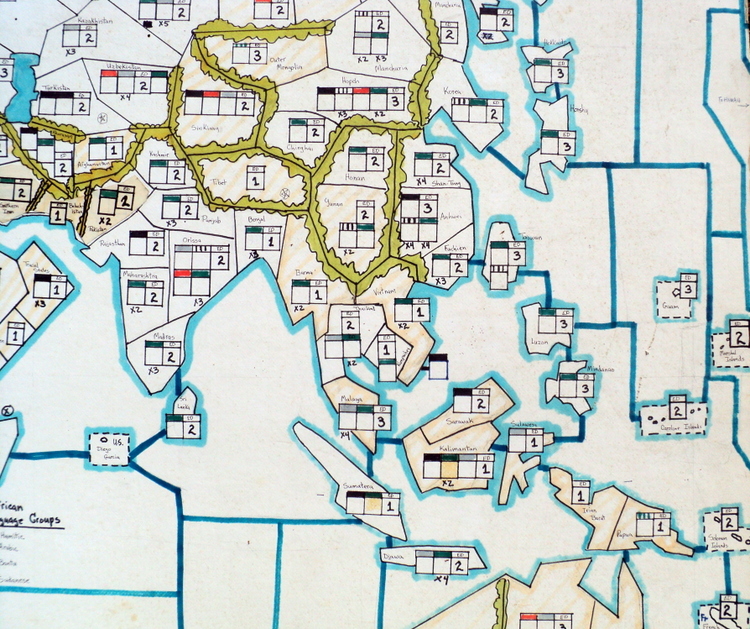 Southeast Asia and Indonesia  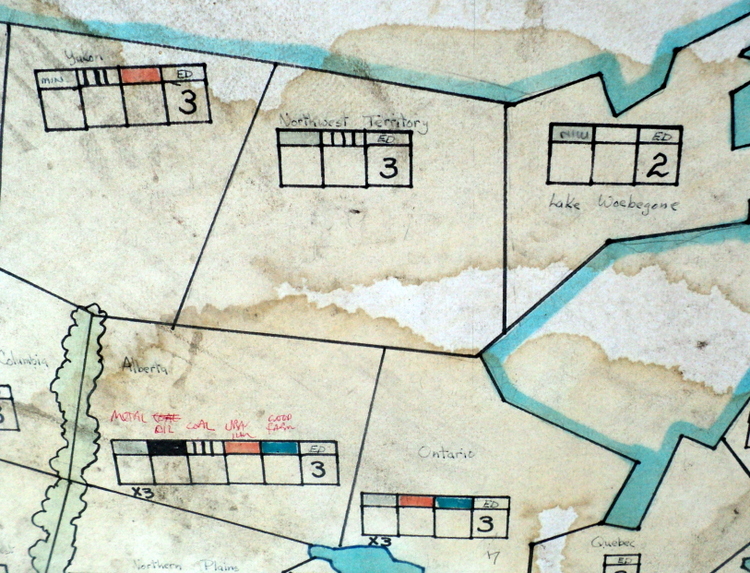 Handwritten notes indicating the meaning of the various boxes: Metal, Oil, Coal, Uranium, Food Farm. "Northern North America, showing Lake Woebegone moved from its "actual" location in Minnesota, and cat pee."  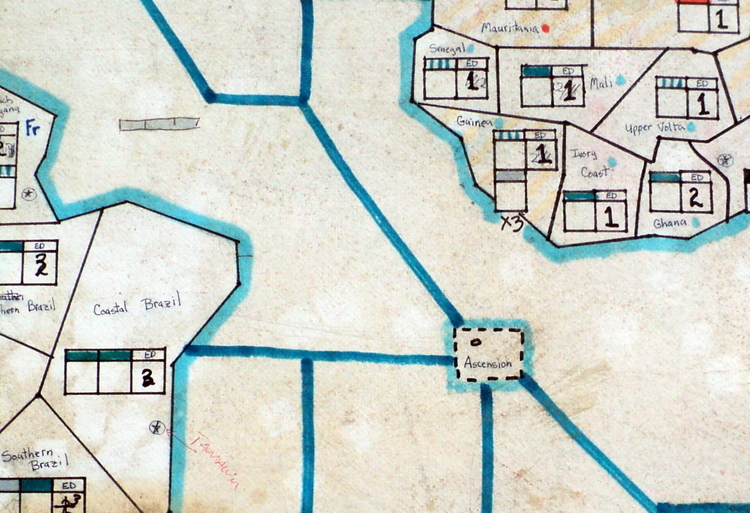 E. coast of Brazil & W. Africa. Note that the circled-star is indicated as tantalum. "Of course, the tantalum was a big driver that showed up later in the game."  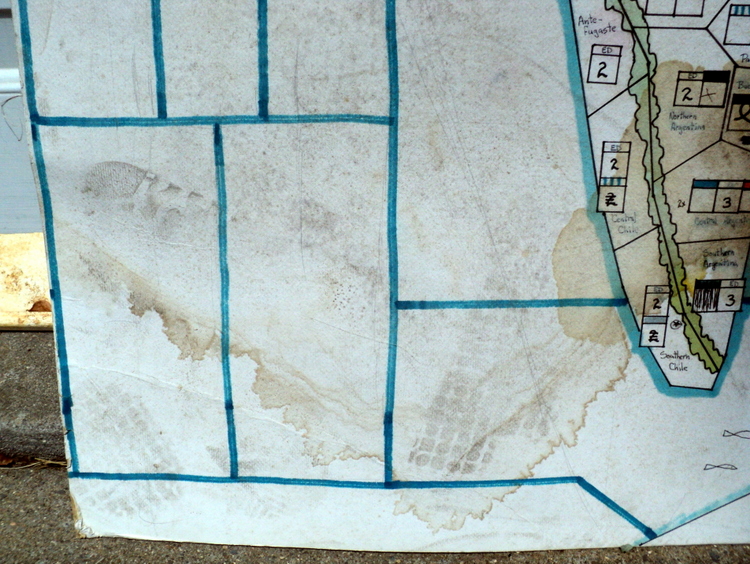 "In some of the photos you can see footprints on the map, along with the cat pee, which explains why I took it upon myself to rescue this. A truly phenomenal amount of GDW historical material was thrown out while I was there, particularly when we vacated the 203 1/2 North Street offices after 20-21 years of continuous occupation. There was a 20+ foot dumpster behind the offices that we filled up during the move to our Empire Street warehouse, where we made new offices in our last year. As the self-appointed GDW "historian" and packrat, I saved what I could, and did triage on stuff making its way down the back steps to the dumpster. A shitload of stuff got lost, and I saved what I could in split-second decisions. Anyone who ever tells you that he has "no regrets" (without a whole lot of qualifications and definitions of what he means by that) is a liar." Special thanks to David Nilsen for the photos and background history. | The Game | 2300 Downloads | | 2300 AD | 7th Sea | AD&D | Aftermath! | Albedo | Aliens | Arduin | Alternity | Amazing Engine | Amber Diceless | Ars Magica | Atlantis | Babylon 5 | Battletech | Boardgames / Wargames - Other | Boot Hill | Buck Rogers | Bushido | Call of Cthulhu | Castle Falkenstein | Chill | Chivalry & Sorcery | Conan | Cyberpunk | Cyborg Commando | Dark Conspiracy | DC Heroes | Deadlands | Doctor Who | DragonQuest | Dream Park | Dune | Dungeons & Dragons | Dying Earth | Earthdawn | Elfquest | Elric / Stormbringer | Everway | The Fantasy Trip | Foreign Language Roleplaying Games | Game of Thrones | Gamma World | GangBusters | Gear Krieg | Ghostbusters | GURPS | Harn | High Fantasy | Indiana Jones | James Bond | Jorune | Judge Dredd | Justifiers | Living Steel | Lords of Creation | Man, Myth & Magic | Marvel Super Heroes | Middle Earth Role Playing | Midkemia | Military Roleplaying Stockpile | Millennium's End | Miscellanea | Morrow Project | Mythus - Dangerous Journeys | Nightlife | Pendragon | Phoenix Command | Powers & Perils | Red Sonja | Renegade Legion | Riddle of Steel | Ringworld | Robotech | Rolemaster | Runequest | Shadowrun | Shatterzone | Sovereign Stone | Space 1889 | Space Master | Space Opera - Other Suns | Star Ace | Star Frontiers | Star Trek | Star Wars | Super Hero RPGs | Talislanta | Talisman | Tekumel | Terminator 2 | Thieves' World | Timemaster | Top Secret | Traveller | Tribe 8 | Tunnels & Trolls | Twilight: 2000 | Villains & Vigilantes | Warhammer | Whispering Vault | Willow | Witchcraft | Ysgarth | CAMPAIGN BUILDING | RPG MAGAZINES | Avalanche Press | Avalon Hill | Bard | Chaosium | Columbia Games | Dream Pod 9 | Fantasy Games Unlimited (FGU) | FASA | Flying Buffalo | Game Designers Workshop (GDW) | Gamelords | Gamescience | Games Workshop | Judges Guild | Leading Edge Games | Mayfair Games | Metagaming | Pacesetter | Palladium | SPI | Steve Jackson Games | Tri Tac | TSR | Victory Games | West End Games | White Wolf | Wizards of the Coast | Yaquinto Publications | | Return Home | What's New | Contact WaynesBooks.com | |
||
 |
 |
